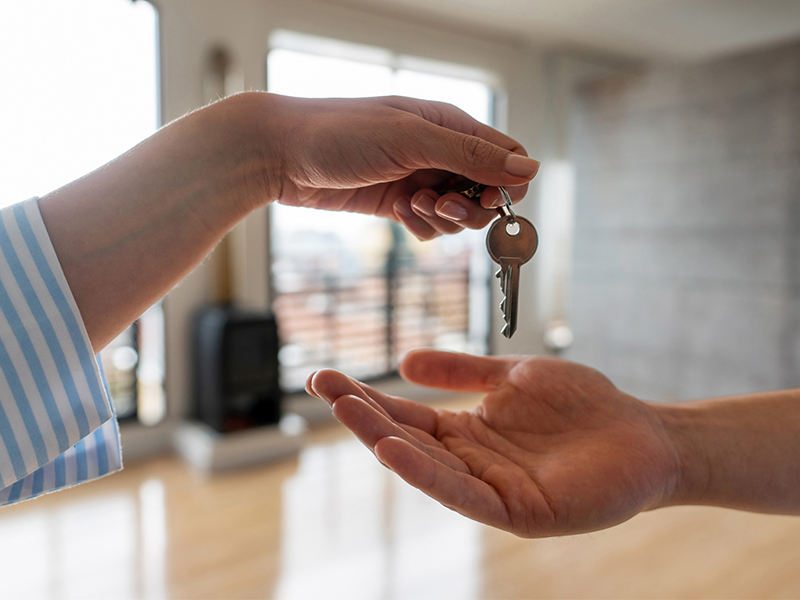
Selling a home can be a thrilling, anxiety-inducing, and very emotional period, sometimes all at the same time. There’s so much paperwork and planning to prepare, plenty of financial and legal considerations, and on top of all this, a seller also has one eye on what happens after they sell their home.
While the task may seem overwhelming, it doesn’t have to be. Here’s a comprehensive checklist for selling a house to help you navigate the process and sell your house in California fast and at the highest price.
Table of Contents:
The Ultimate Selling Checklist
- Hire a real estate agent
- Managing a professional photographer to capture high-quality photos of your home
- Accurate home pricing
- Negotiating the best price
- Creating a compelling real estate listing
- Organizing and hosting showings
- Marketing your property to boost its visibility
- Declutter and depersonalize
- Improve your curb appeal
- Address immediate interior repairs
- Broken kitchen and bathroom tiles
- Loose door and cabinet hinges
- Jammed drawer slides
- Leaky faucets and showers
- Carpet stains
- Splintered hardwood floors
- Faulty light switches
- Damaged doorknobs and locks
- Set the right price
- Sweeten the deal
- Cover all closing costs
- Accommodate buyer’s preferred move-out/move-in schedules
- Agree to all inspections
- Cover expenses related to known buyer issues
- Provide a transferable home warranty with reduced repair and replacement services for household appliances and systems
- Stage your home
- Plan your marketing strategies
- Create an engaging landing page
- Make the most of email marketing
- Sell a lifestyle through storytelling
- Increase your exposure by listing on the MLS
- Spread the word on social media
- Collaborate with local micro-influencers
- Rent a drone for next-level shots
- Organize a unique open house
- Get local businesses involved
- Accept and choose an offer
- Accept the terms as stated and sign.
- Make a counteroffer to the buyer, requesting adjustments. Note that it can take a series of counteroffers to reach an agreement.
- Reject it.
- Negotiate
- Start a bidding war among buyers. Price your home slightly below market value to attract more viewers and generate more offers.
- Invite bidders to submit their best offers. Don’t negotiate with every buyer. Instead, ask them for their highest offer price along with their best sale terms. Buyers are more likely to submit competitive bids when there are multiple offers.
- Set a deadline for counteroffers. This allows you to close a transaction faster or move on to other offers, saving time in negotiations.
- Reject an offer outright. If an offer doesn’t meet your requirements, you can turn it down without a counteroffer. While this doesn’t seem like much of a negotiation technique, it may convince the prospective buyer to completely revise their initial offer.
- Fulfill your disclosure obligations
- Close the deal
- Get the documents ready. These include the purchase agreement, the title report, the loan documents, the inspection report, the appraisal report, the insurance policy, and the closing disclosure. Review these documents carefully and resolve any discrepancies before closing. If you have questions, talk to your real estate agent, your lender, and your attorney.
- Schedule the closing date. Closing agents (usually title companies or attorneys) handle the transfer of property and funds on behalf of the seller or buyer. There’s a 30-45-day closing period after the contract is signed, although it may vary according to the contract terms. Make sure all documents and funds are ready before the closing date and time.
- Conduct a final walkthrough. This gives the buyer a last chance to see the home before closing. It ensures that the property is in the same condition it was in when the contract was signed, which is a day or two before closing. Check that all agreed-upon repairs have been completed.
- Sign the documents. This is the most crucial step in closing a real estate deal. It marks the official transfer of property ownership from the seller to the buyer. A closing agent will walk you and the buyer through the process and explain each document that must be signed. Don’t hesitate to ask questions if anything is unclear in any document. Buyers should present valid IDs, a cashier’s check for closing costs, a wire transfer for the down payment, and proof of home insurance.
- Hand over the keys to the new owner. You should receive closing documents and a check at the end of the transaction.
It’s not mandatory to use a real estate agent when selling your house. However, going the “for sale by owner” (FSBO) route is often a false economy. As the seller with an agent, you’re usually responsible for both buyer’s and seller agents’ commissions. Expect to pay your agent a commission of 2% to 3% of the sale price. If you do choose to go FSBO, you may be able to save on agent fees but you’ll miss out on all tangible and even non-tangible benefits that they bring.
A real estate agent will handle every step of the selling process so you can focus on other matters, making your home-selling experience simple and stress-free. Here are just some of the benefits you get with an agent:
While agents can look after almost all aspects of a home sale, there is often an overlooked benefit they bring. Selling a home can be an incredibly emotional experience, especially if it’s a place where sellers have lived family lives. An agent can be an objective support to lean on during a time that can be both anxious and exciting. They’ll help keep you grounded with your eyes on your objectives and can do much to prevent you from making poor decisions.
Almost all aspects of the selling checklist you’ll see here can be made much simpler and clearer with the help of an agent.

Prepare your home for sale by cleaning visible areas like counters, windowsills, and tables, then move on to covered spaces such as closets and drawers. If the house is overcrowded with belongings, consider donating or storing excess items. Not only will this declutter and depersonalize the property, making it easier for viewers to visualize themselves living in your home, but it will also help you begin the process of saying goodbye to the home before you take on your new adventure.
Buyers will start judging a home even before they’ve seen its exterior. They’ll already be forming opinions the moment they drive into the neighborhood. It’s crucial to create a good first impression. Simple enhancements, such as planting vibrant flowers, repaving the front walkway, updating the house number, repainting the front door, fixing the roof, cleaning the windows, and replacing old light fixtures, are all fixes and enhancements that overall will make a great first impression.
If you’re selling a house in California, ask your real estate agent how other homes in your area have improved their curb appeal before selling. California has a competitive real estate market and it’s prudent to Invest in upgrades if you want your property to stand out.
Upgrades are optional improvements you can invest in to increase your home’s value. Simply fixing a dent in a floor is a repair. Replacing wall-to-wall carpeting with hardwood floors is an upgrade.
If you want to sell your house fast, be mindful of any major upgrades; instead, address issues that turn off buyers, such as:
However, if you have the time and budget, consider updating fixtures, buying new appliances, upgrading cabinet hardware, and painting the interior. Ask your agent first as some upgrades add more to the value of your home than others, and some might not be worth the return on investment.
One of the most effective ways to sell your California house fast is to price it right. Again, your real estate agent can help you determine the value of your property and you can also use many free online tools to get an estimated value.
Use a tool like HomeLight’s Home Value Estimator to know how much your house is worth. This tool provides a free estimate of your home’s value in just two minutes. It’s based on publicly available data, the last sale price, current market trends, and recent sales records.
However, your agent will likely be much more accurate, in that they use “comps”. Comps calculate individual home values and track current market trends. A comparative market analysis (CMA) compares your home to recently sold properties of similar size, condition, and location.
The importance of pricing a property correctly cannot be overstated. Price too low and you are leaving money on the table. Price too high and you could have your property overlooked by buyers who armed with their own agents will steer clear of making any bids or even viewing if they don’t see value in your property.
The situation could get worse in that a home that is on the market for considerably longer than the average selling time for the area could be seen with suspicion. This may force the seller to lower the price continually to generate interest, but by this time the damage is done and the property becomes more difficult to sell.
Now that you’ve set a fair price, consider adding a financial incentive to make your home even more appealing and speed up the selling process. Here’s what you can do:
There are many different strategies and negotiation tactics that a real estate agent can employ to bring about a successful and favorable sale.
Staging is the process of getting your home ready for potential buyers by cleaning, redecorating, and rearranging furniture to showcase your property at its best. The goal is to make the home attractive to many potential buyers. This step can make all the difference if you want to sell your house in California fast and for top dollar.
Staging is best done by professionals. They will assess your property’s current condition to boost its appeal and advise whether you should buy or rent items or repurpose existing furniture and decor. Stagers will also be able to take professional photos of your home, literally showing it in its best light, and as many know, visual impressions are powerful when it comes to generating interest and excitement. Staging comes with a cost, but it makes it much quicker to sell the property.
Note that over 80% of buying agents claim that it was easier for their clients to visualize themselves in a staged home.

The right real estate agent will work with you to create a data-driven marketing plan that appeals specifically to local buyers. Here are some marketing ideas to make your home stand out:
There are numerous factors to consider other than the asking price when accepting and choosing an offer. A good offer is close to, or exactly, the list price. This means you’ve priced your home correctly. A better offer may be made if there are multiple parties interested in your property, then you might be in the fortunate position of being in a bidding war for your property.
It is not always the case that the highest bid wins. While a seller certainly wants to get the most for their property, factors such as the credibility of the bidder, or time contingencies may come into consideration.
Once you’ve read an offer, you can:
After you accept an offer, you can consider a backup offer. However, it will only become effective if the initial offer fails and the transaction doesn’t proceed.
Remember, your agent is there to help you, so take note of their advice. Let your agent know that you accept the buyer’s offer.
Note: An accepted offer is not legally binding until a contract is exchanged.
Buyers and sellers negotiate to reach favorable terms. With the help of an experienced real estate agent, a seller can maximize the final purchase price and secure the best deal. Here are some strategies to consider.
A seller’s disclosure describes the defects and features of the property for sale. It’s required under California Civil Code 1102 and is one of several documents you’ll need to obtain and fill out when selling your home. It applies to properties with one to four residential units.
California disclosure documents are unlikely to jeopardize a transaction unless there is a serious flaw or defect with the property. They provide both parties, especially the buyer, with a level of protection and can prevent future legal issues that may arise between the buyer and seller.
It’s the responsibility of the seller to provide a disclosure statement before transferring ownership. In this way, the termination clause protects the buyer. After receiving the California disclosure form, the buyer may terminate the contract. Buyers usually have three to five days after disclosure to withdraw from agreements.

Finally, the most satisfying part of buying or selling a home is closing the deal. This is where you sign the contract, receive payments, and hand over the keys to the buyer. Here are some tips for successfully closing a real estate deal:
SELL YOUR HOME WITH SEAN CADDELL & ASSOCIATES
Selling your Southern California luxury home will be easier with an experienced real estate advisor on your side. I’m Sean Caddell, and I’m here to help. For the past 20 years, I’ve been selling luxury real estate in Rancho Santa Fe. I work with a team of experienced real estate agents, and we can sell your house fast in California.
If you’re looking for a new home, we can also help you find and acquire some of the best Rancho Santa Fe homes for sale.
Whether you’re selling or buying houses in Rancho Santa Fe, contact us at 858.472.1074 or via email.

